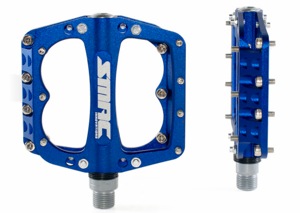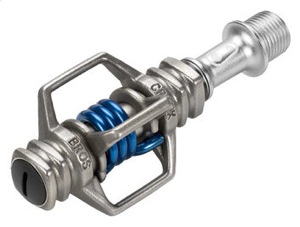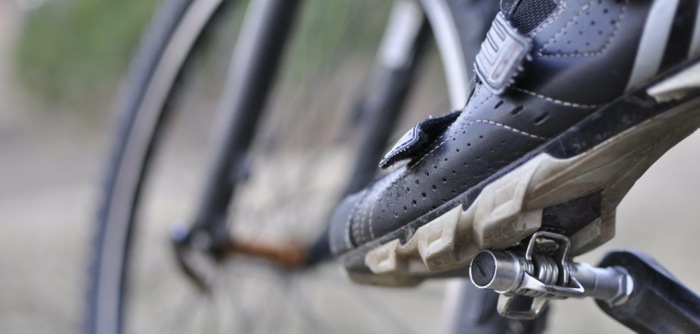You've no doubt seen countless riders cruising around on clipless pedals. Those super tiny pedals that allow the rider to actually clip-in and attach to the bike... It's a scary thought, especially in reference to mountain biking (MTB). What could possibly be worse than riding up to an obstacle, only to realize you're attached to the bike! Well as it turns out, it's not that bad. In fact, you're completely overreacting, and it might be time for you to take a leap of faith.
First off, a quick explanation as to the name: Clipless Pedals? The name is in reference to when pedals only ever had straps on them, which went over your shoes. These straps were called clips, but pedals don't have these straps anymore. This means they're 'clipless' pedals.
FLAT PEDALS
The more traditional style of pedal is your old school flat pedal, or 'flats' if you want to sound savvy. Flat pedals have a strong following in various styles of riding, usually with riding that involves removing your feet from the pedals more often than you would in cross country mountain biking.

- Dirt Jumping
- Downhill
- Enduro Downhill
- Freeride
- Slopestyle
There are all types of off-road cycling that demand more of a Motocross style of riding, with feet used to keep the rider upright through insanely fast, drifting corners. This type of riding also involve more falls and crashing, not a scenario favored towards clipless pedals!
Beginner riders are also encouraged to use flat pedals, just to allow them to get use to riding the bike first, before adding another parameter of fear to the equation. It's enough for a beginner to negotiate the basic stuff, let alone expecting them to clip in and out. So if you know any beginners play nicely and get them into it slowly. Confidence is crucial in riding progression, not which pedals you force them to use!
CLIPLESS PEDALS
Clipless pedals are a natural progression for most cross country riders, or anyone who doesn't have the need to press 'EJECT' halfway through their ride. In saying this, clipless pedals are very easy to disengage from, so in the event of a fall you'll find both feet will unclip of their own accord.
The benefit of clipless pedals is in their attachment to your feet. You can do all of the following, simply because your feet are now attached to the pedals:

- Pull up when pedaling, as well as push down. This means more power output
- Downhill
- Remain on the bike when you hit rough stuff - no more accidental foot slippage
- Control the back wheel separately to the front wheel
- Bunny hop more easily, and potentially higher to clear obstacles
You are also able to upgrade your shoes to a more suitable MTB shoe. These shoes are compatible with your new clipless pedals, and offer far more foot protection and sole stiffness. Having a stiffer sole allows you to have a more stable pedaling platform, which is handy when you really want to stomp on those pedals!
Further reading: "Clipless Shoes and Pedals: What’s the Point?" goes into further detail about the benefits of clipping-in.
COMPARE THE PAIR
As with all the recommendations we make, you really have to take a closer look at your personal riding requirements. Are you looking to hang loose through a corner at 40mph before hitting a 20 foot step up and into a double tailwhip barspin? Or are you more likely to fly through a rock garden, before hopping over a log and then up a steep 13% gradient climb?
Extreme styles of riding would be more likely to suggest a flat pedal, for reasons mentioned above. Cross country riding would be more suited to your clipless pedals, allowing you to have more control over the bike, and ride with more finesse.
But this is where riding preference comes in and turns logic on its head! Some Downhill / Freeride riders actually prefer riding 'double sided' pedals, whereby they can choose to clip in or just ride the pedals as flats! The reason for this is that the rider might want the option of increased power to the pedals, as well as reducing the chance of slipping a foot off the pedals...
Similarly in the cross country world, a small handful of riders still prefer to ride on flat pedals. This group of riders might have a background of riding on flats, and don't feel the need to switch to clipless pedals.

WHAT'S BEST FOR ME?
Pop down to your local shop and discuss the style of riding you take part in. You'll find that your shop assistant would recommend clipless pedals for your next cross country MTB ride to maximize control and efficiency on the bike. For general riding purposes such as commuting, you'll find the same recommendation will come to the fore.
But if you intend launching off a cliff, or clearing a canyon gap, you'll no doubt be recommended flat pedals. That and maybe some body armor.



